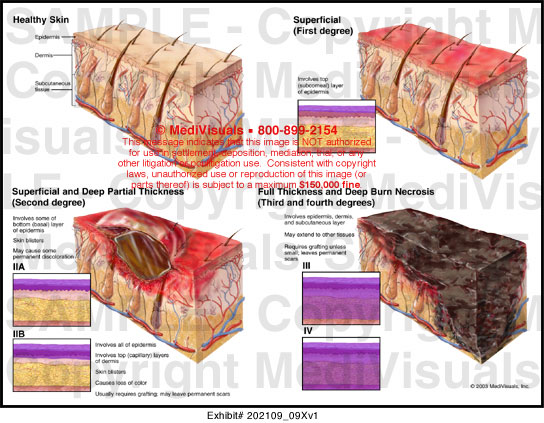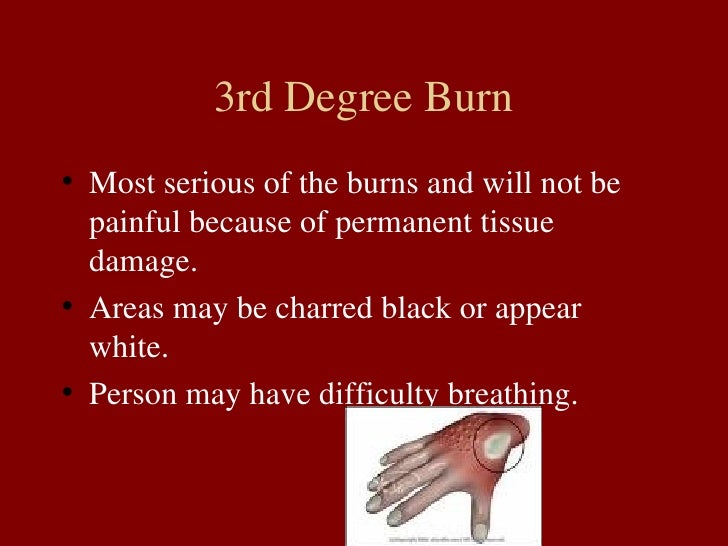
Fourth-degree burns are not recognized by the medical community and are not included in the classification system for burns. The severity of a burn is determined by its degree, and the highest degree of burn is a third-degree burn. 8 Patients who require intubation tend to have larger and deeper burns. No, there is no such thing as a fourth-degree burn. A recent study indicated that one third of hospitalized patients with burns were extubated within 1 day after admission. These burns require immediate medical attention and can take months to heal. Symptoms of a third-degree burn include white or blackened skin, numbness, and severe pain. They affect all layers of the skin, including the epidermis, dermis, and subcutaneous tissue. Third-degree burns are the most severe type of burn. These burns usually heal within two to three weeks with medical treatment. Symptoms of a second-degree burn include redness, pain, swelling, and blistering.
#4th degree burn symptoms skin
They affect both the epidermis and the layer of skin beneath it, known as the dermis. Second-degree burns are more severe than first-degree burns. Without medical attention, these burns normally heal within a few days. A first-degree burn causes redness, discomfort, and edema. They only affect the epidermis, or the outer layer of skin. Types of Burns First-Degree Burnsįirst-degree burns are the mildest form of burn. The degree of a burn is based on how deep and extensive the damage is. Burns can range from mild to severe, and the severity of a burn is determined by its degree. If you have asthma, another lung disease, or heart disease, follow your health care provider's advice about your medicines and respiratory management plan.Photo by Roman Downs on What Is a Burn?Ī burn is an injury to the skin caused by heat, electricity, radiation, or chemicals.
#4th degree burn symptoms windows
Keep your indoor air as clean as possible, by keeping windows closed and using an air filter. If there is smoke from a wildfire nearby or lots of particulate pollution in the air, try to limit your time outdoors.At home, practice fire safety, which includes preventing fires and having a plan in case there is a fire.You can take steps to try to prevent inhalation injuries:

Smokers and people who had a severe injury are at a greater risk of having permanent problems. Most people get better, but some people have permanent lung or breathing problems. Some patients need to use a ventilator to breathe. Treatment is with oxygen therapy, and in some cases, medicines. If you have an inhalation injury, your health care provider will make sure that your airway is not blocked. Other possible tests include imaging tests of the lungs, blood tests, and lung function tests. Additionally, burn injury affects all organs to some degree, owing to the systemic response to the burn.

To make a diagnosis, your health care provider may use a scope to look at your airways and check for damage. If you have a chronic heart or lung problem, an inhalation injury can make it worse. Symptoms of inhalation injuries can depend on what you breathed in. The treatment of burns depends on the location and severity of the damage.

Burns can be minor medical problems or life-threatening emergencies. Over half of deaths from fires are due to inhalation injuries. Overview Second-degree burn Burns are tissue damage that results from heat, overexposure to the sun or other radiation, or chemical or electrical contact. Inhalation injuries can also be caused by extreme heat these are a type of thermal injuries. They can happen if you breathe in toxic substances, such as smoke (from fires), chemicals, particle pollution, and gases. The burn site may look white or blackened and charred.' and a 'Fourth-degree burns go through both layers of the skin and underlying tissue as well as deeper tissue, possibly involving muscle and bone. They may go into the innermost layer of skin, the subcutaneous tissue. Inhalation injuries are acute injuries to your respiratory system and lungs. Third-degree burns destroy the epidermis and dermis.


 0 kommentar(er)
0 kommentar(er)
